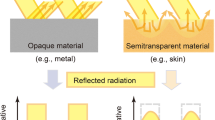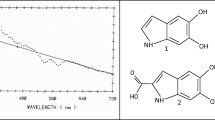Abstract
The epidermal melanin content affects most dermatologic treatments involving light, and can limit the therapeutic success significantly. Therefore, knowledge of the optical properties of skin is required. This study investigates how the concentration of melanin influences visible reflectance spectra of skin and the relationship to threshold radiant energy fluence for melanosomal or melanocyte destruction. Reflectance spectra were measured at 28 pigmented human skin sites in vivo. For Asian and Caucasian subjects, measured reflectance values varied over the same range, while significantly lower values were recorded for African individuals. Epidermal melanin absorption coefficients measured at 694 nm were about 2500 m-1 for African, and 300–1200 m-16 for Caucasian and Asian skin. Twenty-five skin sites were exposed to ruby laser pulses (694 nm), where the pulse duration was long enough to allow heat diffusion between melanosomes. Hypopigmentation occurred, on average, at 12 and 26 J cm-2 for sun-exposed and sun-protected white skin, respectively, while slightly lower threshold values resulted from the measured spectra. As visible reflectance spectra reveal information regarding skin pigmentation and individual threshold doses for melanosomal damage, a use as a diagnostic tool in various dermatological laser treatments is apparent.
Similar content being viewed by others
References
Anderson RR, Parrish JA. The optics of human skin.J Invest Dermatol 1981,77:13–9
Taber’s Cyclopedic Medical Dictionary. FA. Philadel- phia: Davis Co. 17th edn, 1993
Anderson RR, Parrish JA. Selective photothermolysis: precise microsurgery by selective absorption of pulsed radiation.Science 1983,220:524–7
Ara G, Anderson RR, Mandel KG et al. Irradiation of pigmented melanoma cells with high intensity pulsed radiation generates acoustic waves and kills cells.Lasers Surg Med 1990,10:52–9
Hruza GJ, Dover JS, Flotte TJ et al. Q-Switched ruby laser irradiation of normal human skin.Arch Dermatol 1991,127:1799–805
Jacques SL, McAuliffe DJ. The melanosome: threshold temperature for explosive vaporization and internal absorption coefficient during pulsed laser irradiation.Photochem Photobiol 1991,53:769–75
Hohenleutner U, Hilbert M, Wlotzke U, Landthaler M. Epidermal damage and limited coagulation depth with the flashlamp-pumped pulsed dye laser: a histochemical study.J Invest Dermatol 1995,104:798–802
Svaasand LO, Norvang LT, Fiskerstrand EJ et al. Tissue parameters determining the visual appearance of normal skin and port-wine stains.Lasers Med Sci 1995,10:55–65
Norvang LT, Fiskerstrand EJ, Bakken B et al. The influence of tissue parameters on visual reflectance spectra of port-wine stains and normal skin.SPIE Europto Series 1995,2623:2–14
Kollias N, Baqer A. On the assessment of melanin in human skin in vivo.Photochem Photobiol 1986,43:49–54
Hajizadeh-Saffar M, Feather JW, Dawson JB. An investigation of factors affecting the accuracy of in vivo measurements of skin pigments by reflectance spectrophotometry.Phys Med Biol 1990,35:1301–15
Bridelli MG, Crippa PR. Optical properties of melanin; a comment.Appl Opt 1982,21:2669–70
Sliney D, Wolbarsht M.Safety with Lasers and Other Optical Sources. A Comprehensive Handbook, 4th edn. New York: Plenum Press, 1980:pp. 94–5
Moschella SL, Hurley HJ.Dermatology, 3rd edn. London: W. B. Saunders, 1992:pp. 1421–35
Moschella SL, Hurley HJ.Dermatology, 3rd edn. London: W. B. Saunders, 1992:pp. 24–8
Scheibner A, McCarthy WH, Nordlund J. Age and seasonal variation in melanocyte distribution in normal human epidermis. In: Kligman AM, Takase Y, Gilchrest BA et al. (eds)Cutaneous Aging. Tokyo: University of Tokyo Press, 1988:p. 201
Lever WF, Schaumburg-Lever G.Histopathology of the Skin, 7th edn. Philadelphia: J. B. Lippincott Company, 1990:p. 10
van Gemert MJC, Jacques SL, Sterenborg HJCM, Star WM. Skin optics.IEEE Trans Biomed Eng 1989,36:1146–54
Wan S, Anderson RR, Parrish JA. Analytical modeling for the optical properties of the skin with in vitro and in vivo applications.Photochem Photobiol 1981,34:493–9
Anderson RR, Parrish JA. Optical properties of human skin. In: Regan JD, Parrish JA (eds)The Science of Photomedicine. New York: Plenum Press, 1982:pp. 147–94
Jacques SL, Alter CA, Prahl SA. Angular dependence if He-Ne laser light scattering by human dermis.Laser Life Sci1987,1:309–33
Graaff R, Dassel ACM, Koelink MH et al. Optical properties of human dermis in vitro and in vivo.Appl Opt 1993,32:435–47
Hardy JD, Hammel HT, Murgatroyd D. Spectral transmittance and reflectance of excised human skin.J Appl Physiol 1956,9:257–64
Prahl SA.Light Transport in Tissue. Ph.D. dissertation, 1988, cited in Graaff et al. (ref. 22)
Hillenkamp F. Interaction between laser radiation and biological systems. In: Hillenkamp F, Pratesi R, Sacci C (eds)Lasers in Biology and Medicine. New York: Plenum Press, 1979:pp. 57, 61
van Gemert MJC, Welch AJ, Miller ID, Tan OT. Can physical modeling lead to an optimal laser treatment strategy for port-wine stains? In: Wolbarsht ML (ed)Laser Applications in Medicine and Biology. New York: Plenum Press, 1991,5: 199–275
Svaasand LO, Milner TE, Anvari B et al. Epidermal heating during laser induced photothermolysis of port wine stains: modeling melanosomal heating after dynamic cooling of the skin surface. SPIEEuropto Series 1994,2323:366–77
Norvang LT, Fiskerstrand EJ, Nelson JS et al. Epidermal melanin absorption in human skin. SPIEEuropto Series 1995,2624:143–54
Nelson JS, Milner TE, Anvari B et al. Dynamic epidermal cooling during pulsed laser treatment of port wine stain. A new methodology with preliminary clinical evaluation.Arch Dermatol 1995,131:695–700
Haskell RC, Svaasand LO, Tsay T-T et al. Boundary conditions for the diffusion equation in radiative transfer.J Opt Soc Am A 1994,11:2727–41
Duck FA.Physical Properties of Tissue. London: Academic Press, 1990
Author information
Authors and Affiliations
Rights and permissions
About this article
Cite this article
Norvang, L.T., Milner, T.E., Nelson, J.S. et al. Skin pigmentation characterized by visible reflectance measurements. Laser Med Sci 12, 99–112 (1997). https://doi.org/10.1007/BF02763978
Received:
Revised:
Accepted:
Issue Date:
DOI: https://doi.org/10.1007/BF02763978




